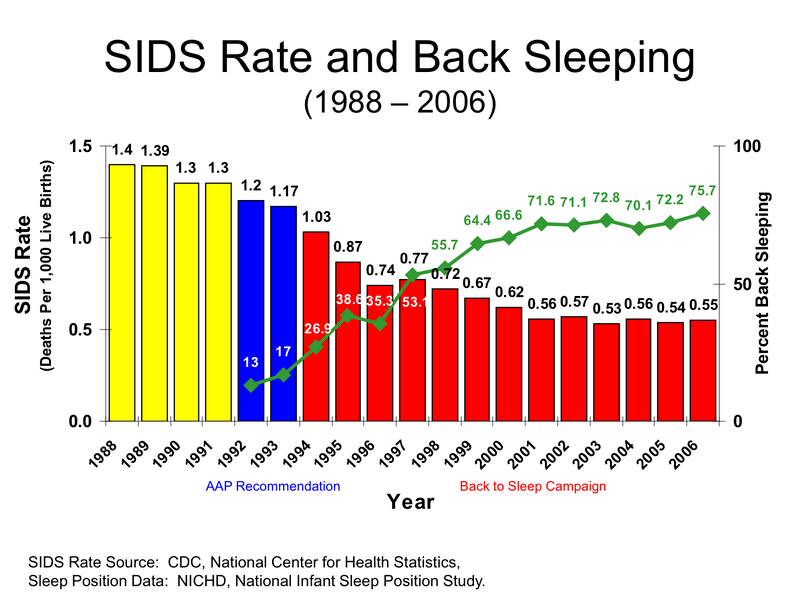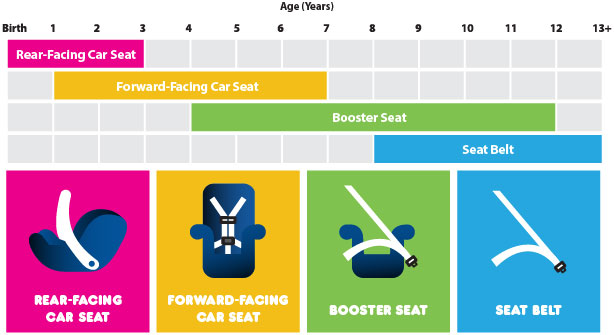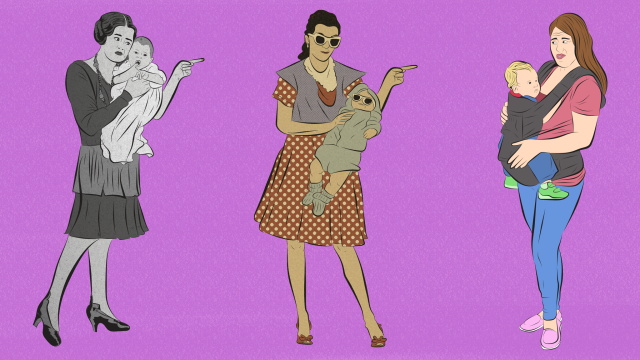Parenting advice changes over time, so if you’re a new parent you may be dodging weird advice from your parents. Or if you’re a total parenting know-it-all, some whippersnapper might try to tell you things are different now. Here’s everything that’s changed and why, according to pediatricians and safety experts.
Illustration by Sam Woolley.
Baby Bumpers Are a Bad Idea
Bumpers are cushions that tie onto the crib rails. They became popular because it seemed like a good idea to protect babies from bonking their heads on the hard wooden or metal rails, and because crib rails in those days were farther apart and parents worried that a baby might fall out, or might get stuck between the rails.
But after investigating deaths related to bumpers, the American Association of Pediatrics (AAP) concluded that bumpers aren’t worth the risk: children were suffocating or getting wedged between bumpers and mattresses.
Go into a store selling baby things, though, and you’ll often find the display cribs overflowing with matching quilts and softies and bumpers. The bumper makers continue to sell them by citing “a recent study” on their safety that happens to have been commissioned by the bumper makers themselves. So, yes, bumpers are for sale, they often come as part of bedding sets, and maybe they look cute and cosy. But that doesn’t mean it’s a good idea to use them. I’d trust paediatricians over bumper manufacturers there.
Babies Sleep on Their Backs (for a Good Reason)

We put babies to sleep on their backs nowadays, to reduce the risk of Sudden Infant Death Syndrome (SIDS). This recommendation was publicised by the US “Back to Sleep” campaign beginning in 1994 and a similar Australian campaign in 1991, so most of the folks becoming grandparents are now hearing the advice for the first time. And in many cases, their response is “What? We put you on your belly to sleep, and you turned out just fine!”
And that’s true, but some babies did not turn out just fine. Of every 1000 babies born in 1988, for example, 1.4 died of SIDS. Now that parents are more aware of the condition, and over 75 per cent go to sleep on their backs, the number of SIDS deaths is less than half of what it used to be.
Following the guideline can be frustrating because babies often sleep better on their bellies. And it’s a tough switch for the grandparents because they were probably told that it was dangerous for babies to sleep on their backs. The concern at the time was that babies might choke on their spit-up, but it turns out that fear was unfounded.
There’s more to safe sleep than laying babies on their backs, though. The rest of the recommendations for safe sleep can help prevent all kinds of horrible things you’d rather not think about, like suffocation. Some of the key recommendations, besides back sleeping and avoiding bumpers, are:
- Use a firm mattress, nothing soft and squishy.
- Make sure the baby doesn’t get too hot (look for sweating and flushed cheeks).
- Consider using a dummy (it seems to help).
- Don’t have any blankets, pillows or stuffed animals in the crib.
Checking every ten seconds to see if the baby is breathing is not one of the necessary steps, but we know you’re going to do that anyway.
Solid Foods Are For Six-Month-Olds
By six months, give or take, a baby will be ready to eat “solid” food — in other words, food that’s not breastmilk or formula. Your baby’s digestive system isn’t ready for new kinds of food earlier than that.
Older guidelines sometimes suggested introducing solids earlier. Some parents are still trying to introduce solids before four months, because they believe it will help the baby gain weight faster or because they want the baby to sleep through the night. That rarely works, but more importantly it seems to put the kid at greater risk of asthma, diabetes and obesity.
Some folks from the “great-grandparental” generation may even suggest putting finely powdered baby cereal in a baby’s bottle at an early age, but that’s definitely outdated advice. In the olden days, some experts recommended starting solids within days or weeks of birth, sometimes citing a belief that formula and breastmilk were missing essential vitamins and minerals. That was true of the formula of the time — it was missing iron — but it’s not true of formula today and was never true of breastmilk.
The exact right age to introduce solids varies with the baby. The World Health Organisation names six months as the correct age to start, but some babies might be ready earlier. (One of my sons was swiping bread off the table at five months, chewing with his little gums and swallowing like a champ.) Some guidelines suggest “four to six months”, but that doesn’t mean you should be waiting with a spoon and a jar of baby food the second the kid turns four months old.
Instead, organisations like the AAP recommend watching for developmental cues: a baby who is ready for solids will seem interested in putting food in their mouth, will swallow it rather than letting it dribble onto their chin, and will be strong enough to sit up or at least hold their head up while sitting in a high chair.
By the way, water goes along with solid foods: it’s likewise not recommended until six months, even on hot days. Babies get the water they need from breastmilk or formula, and drinking water at such a young age can even harm their kidneys.
Peanut Butter and Other ‘Allergenic’ Foods Are Fair Game
For a while, there was a taboo on feeding a very young baby “allergenic” foods. The theory was that an early introduction of peanut butter, for example, might make a child more likely to be allergic to peanuts. But it turns out the reverse is true: you should introduce these around the same time as other solid foods, working them into the rotation after six months. Delaying them may increase the chance of allergies.
Commonly allergenic foods are dairy, egg, soy, wheat, peanuts and tree nuts and fish and shellfish. The American Academy of Allergy, Asthma and Immunology recommends using a little more caution with these foods than with the old standards. That means introducing those foods one at a time, after trying other solid foods, and doing it at home so that if the kid does turn out to be allergic, you’re not trying to deal with that in the middle of a restaurant. That advice is for kids without a high risk for allergies. If you have reason to think your child might have an allergy — like if their sibling is allergic — talk to their doctor before introducing that food.
There Are a Lot More Immunisations, for the Better
At her two-month appointment, my daughter received protection against eight different diseases — and thanks to combination vaccines, they came in a total of three needles. It’s true that kids today get more shots than they used to, but don’t think for a minute that there are “too many”. Consider this statistic from the AAP’s review of whether vaccines can overwhelm a child’s immune system (spoiler: nope):
Although we now give children more vaccines, the actual number of antigens they receive has declined. Whereas previously 1 vaccine, smallpox, contained about 200 proteins, now the 11 routinely recommended vaccines contain fewer than 130 proteins in total.
The schedule of recommended vaccines may seem a little random, but it’s actually designed to get each vaccine to your child at the earliest age they can safely receive it. Some of the shots are either too risky or not effective if a baby gets them at too young an age. But as soon as a vaccine becomes safe, it’s a good idea to get it as soon as possible, so that the kid isn’t vulnerable any longer than they need to be. The AAP explains the logic behind the schedule here, and why “alternative” schedules that space out vaccines just introduce risk without benefit.
Car Seat Rules Are Stricter

If you remember riding in the front seat as a wee tot, sorry — the front is only for age 12 and up. There are more changes, too. Here are the current recommendations:
- Babies should be in a rear-facing car seat as long as possible, until at least age two. Yeah, they may have to sit with their legs scrunched up. They will live.
- Once they outgrow that seat, kids should sit in a forward-facing seat with a harness and tether for as long as that seat can hold them.
- From there until age 12, they should sit on a booster seat. Younger kids will need a booster with a back to hold the seatbelt in a safe position.
These changes are all, of course, in the interests of safety. The big problem with the front seat is the air bags; they can hurt a kid in a crash (especially a baby in a rear-facing seat). If your car only has a front seat, look for a switch to turn off the air bag.
Activity Centres Are Safer Than Walkers
Wheeling around looks like a fun way for a baby to entertain themselves when they can barely walk. But a baby can get into a lot of trouble in a walker: kids have tipped over, fallen down stairs and managed to get in reach of hot stoves.
The AAP has called for a ban on all kinds of wheeled infant walkers, but they’re still in stores. They have some safety features that older walkers didn’t: brakes that are triggered if they start to roll off a ledge, for example. They’re also wider than a standard doorway, so you can keep the kiddo contained even if they manage to get the walker going fast enough to slam baby gates open.
With those changes, and with supervision and good baby-proofing, walkers aren’t exactly death traps. Paediatricians don’t like them anyway, citing concerns that they might delay babies’ development. Instead of walkers, the AAP and other safety-conscious groups recommend stationary activity centres (Exersaucer is one brand) that let kids stand and bounce and swivel while they stay in one spot.
Changes in the recommendations for baby care may seem frustratingly arbitrary, but they reflect our changing understanding of what works best for kids, and what is safest for them. Some of these changes, like the ones about car seats and vaccines, even have the potential to save your child’s life. So consider embracing the new guidelines — even though it’s been said that the only person who likes change is a wet baby.

Comments
8 responses to “Your Guide To Avoiding Outdated Baby Care Advice”
You can also get mesh bumpers which are super easy to breath through.
Breast milk is good but if you are not producing enough, it’s fine to supplement with formula. It was a nightmare with our first, he was always hungry. So much easier with the second and without any guilt.
Second this or if like us your baby is bad at latching properly and therefore tends to work harder for less milk then introducing solids earlier (ours was between 5 & 6 months) or using formula to supplement breast milk worked for us (with consultation from a doctor).
A booster seat until 12 years old? That seems like a crazy long time, is that normal these days? We’re having our first in June.
Depends on where you live. The seat and airbag recommendations above seem to be from American standards. For Australian kids the rules are different, usually based on weight and height.
QLD child restraint laws for example have
0-6 months – Rearward facing restraint
6 months to 4 years – Rearward or Forward facing restraint with harness following manufacturers instructions for when the seat can be turned.
You can buy a seat that is 0 months to 4 years. It will tilt up and down and be turnable.
4-7 years forward facing restraint with hardness or secured adult seatbelt (secured seatbelt means there are clips that make sure the lap part of the belt sash stays firmly down on the kids legs to prevent ‘submarining’ (sliding out from under the lap sash)
Source: Have 9 year old and 4 year old. Have used same seat for both.
http://www.tmr.qld.gov.au/safety/driver-guide/child-restraints/child-restraint-laws.aspx
Just re-read what i wrote. The new standards in QLD are based on height, not weight. My bad.
Right ok, thanks! I guess I still don’t really have to think about it for a few more years.
I wonder what the recommendations were when I was a child, because I was definitely out of the booster seat by the time I was 5.
Thanks for the advice, which I assume is current. But this article tells me nothing about how to avoid outdated advice.